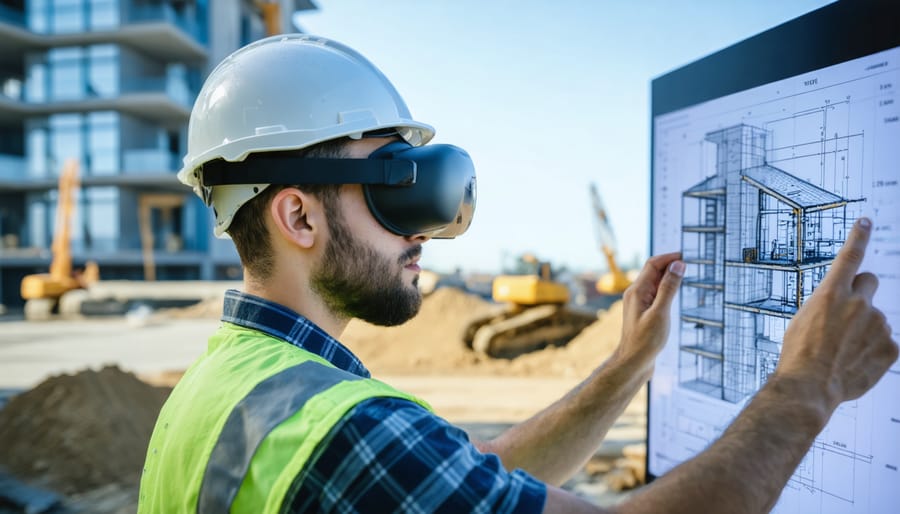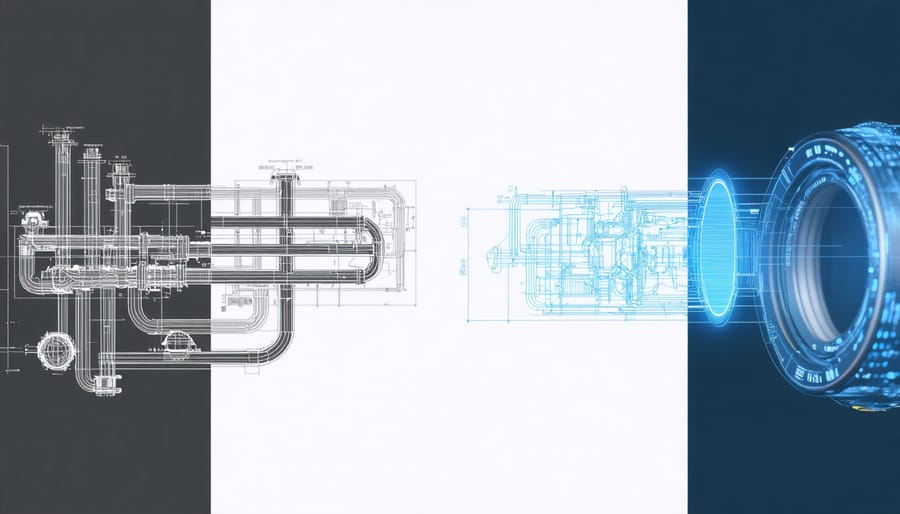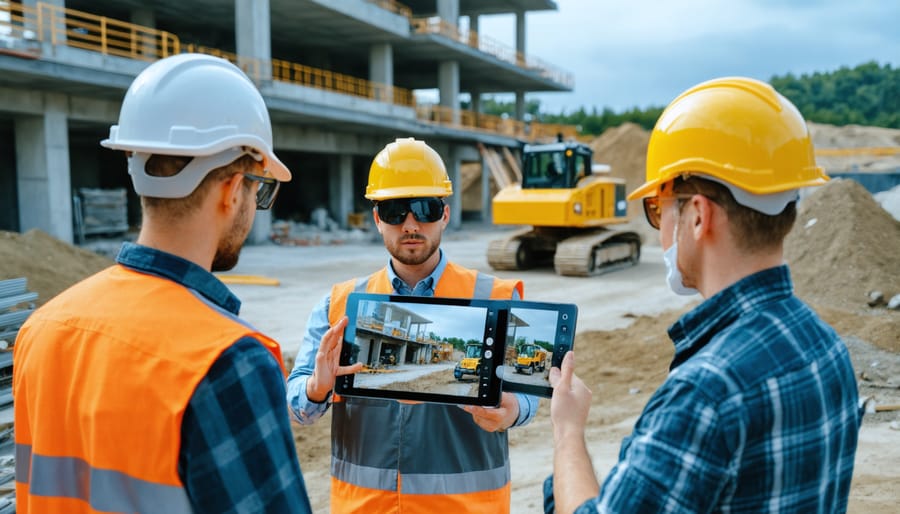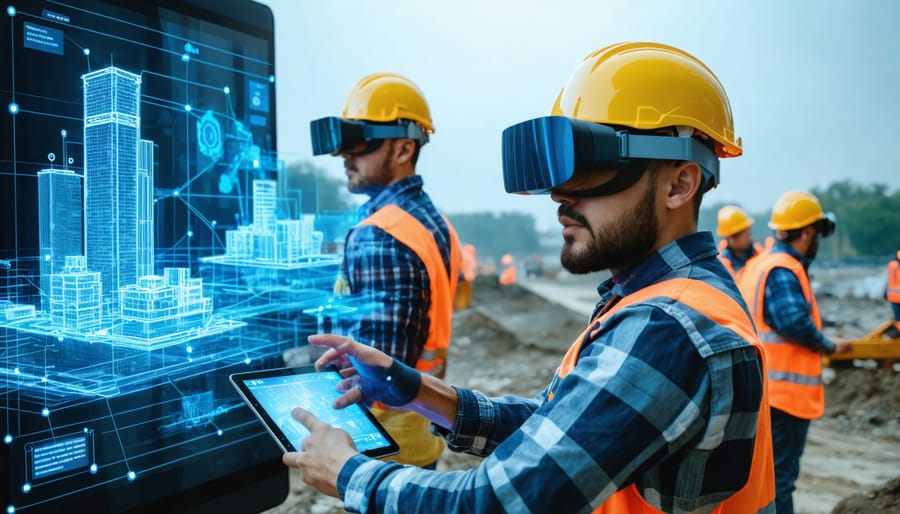Augmented reality is revolutionizing construction project delivery, enabling real-time 3D visualization of building components before they’re physically installed. Through AR-enabled devices, construction teams now overlay BIM models directly onto job sites, detecting clashes, verifying installations, and reducing costly rework by up to 40%. This technological leap forward merges digital precision with physical construction, allowing project managers to identify potential conflicts, optimize workflows, and enhance collaboration between stakeholders at every project phase.
Industry leaders implementing AR solutions report significant improvements in project efficiency, with some documenting up to 25% reduction in schedule delays and substantial cost savings through early issue detection. From foundation work to MEP systems installation, AR technology provides unprecedented accuracy in positioning building components, while enabling remote expertise sharing and real-time decision-making across global project teams.
The integration of AR in construction represents more than just technological advancement – it’s a fundamental shift in how we approach building design, execution, and quality control. As construction firms increasingly adopt these solutions, AR is becoming an essential tool for maintaining competitive advantage in an industry where precision and efficiency directly impact the bottom line.
Real-Time Building Visualization: The AR Advantage
BIM Integration with AR
The convergence of BIM and AR integration represents a transformative advancement in construction project visualization and management. By overlaying BIM models onto real-world construction sites through AR devices, project teams can instantly access and interact with complex structural data in three dimensions. This integration enables stakeholders to visualize completed structures before construction begins, detect potential conflicts, and make informed decisions during the building process.
Construction professionals using AR-enabled BIM can perform real-time clash detection, verify installation accuracy, and conduct virtual inspections with unprecedented precision. The technology allows teams to compare as-built conditions against design models, ensuring construction adheres to specifications and identifying discrepancies early in the project lifecycle.
Field workers equipped with AR headsets can access BIM data hands-free, viewing precise component locations, installation instructions, and maintenance procedures overlaid directly onto their field of vision. This capability significantly reduces errors, accelerates construction timelines, and improves overall project efficiency.
Furthermore, the integration facilitates better collaboration among project stakeholders. Architects, engineers, and contractors can simultaneously view and interact with the same BIM model through AR interfaces, enabling real-time problem-solving and decision-making. This collaborative approach minimizes communication gaps and ensures all team members work from the most current project information.

On-Site Digital Overlays
On-site digital overlays represent one of the most transformative applications of augmented reality in construction, enabling real-time visualization of building information directly on the construction site. Through AR-enabled devices such as tablets, smartphones, or smart glasses, construction professionals can view 3D BIM models superimposed onto the physical environment, creating an intuitive blend of digital and real-world elements.
These overlays serve multiple critical functions during construction. Workers can visualize hidden infrastructure, such as electrical conduits and plumbing systems, before cutting into walls or concrete. Project managers can compare as-built conditions against design specifications in real-time, identifying discrepancies immediately rather than discovering them later in the construction process.
The technology utilizes sophisticated tracking systems, combining GPS data, computer vision, and spatial mapping to maintain precise alignment between digital models and physical structures. Modern AR systems can achieve positioning accuracy within millimeters, essential for complex installation tasks and quality control verification.
Construction teams use these overlays for various applications, including precise equipment placement, safety zone visualization, and installation guidance. For instance, mechanical contractors can see exactly where HVAC components should be installed, while electrical teams can visualize optimal cable routing paths through walls and ceilings.
The real-time nature of these overlays facilitates immediate decision-making and problem-solving on site, significantly reducing the need for reference documentation and minimizing the risk of installation errors.
Smart Building Systems Through AR Lens
MEP Systems Visualization
AR technology has revolutionized how construction teams visualize and manage complex MEP systems during both design and installation phases. By overlaying virtual representations of mechanical, electrical, and plumbing components onto the physical construction space, AR creates an intuitive understanding of system layouts and potential conflicts. This capability, often integrated with digital twins technology, enables teams to identify spatial conflicts and optimization opportunities before installation begins.
Construction professionals can now visualize hidden MEP elements through walls and ceilings, effectively seeing through building structures to understand system relationships and connections. This enhanced visibility significantly reduces installation errors and improves coordination between different trade contractors. Using AR-enabled devices, installers can precisely locate connection points, verify clearances, and ensure proper routing of systems in real-time.
The technology proves particularly valuable in retrofit projects, where teams must integrate new systems within existing infrastructure. AR overlays help technicians understand the location of existing utilities and plan optimal installation paths while avoiding conflicts. This capability has been shown to reduce rework by up to 25% and accelerate installation timeframes significantly.
Recent advancements in AR platforms now allow for real-time collaboration, enabling remote experts to guide on-site teams through complex MEP installations, further enhancing efficiency and accuracy in system deployment.

Energy Performance Monitoring
Augmented reality is revolutionizing how building professionals monitor and optimize energy consumption in modern construction projects. By overlaying real-time energy data onto physical building elements, AR technology enables facilities managers and engineers to visualize energy flows, identify inefficiencies, and implement immediate corrective actions.
Through AR-enabled devices, professionals can access comprehensive thermal mapping, HVAC performance metrics, and utility consumption patterns in an intuitive, visual format. This enhanced visibility allows for rapid identification of energy leaks, equipment malfunctions, and opportunities for energy performance optimization.
Leading construction firms are implementing AR solutions that integrate with Building Management Systems (BMS) to provide instant feedback on energy usage patterns. Maintenance teams can view real-time performance data by simply pointing their AR devices at specific building components, enabling swift diagnosis of issues and more efficient maintenance scheduling.
The technology also supports predictive maintenance by highlighting equipment approaching critical efficiency thresholds before failures occur. This proactive approach has demonstrated significant cost savings, with some projects reporting up to 30% reduction in energy-related operating expenses through AR-assisted monitoring and maintenance programs.
As sustainability requirements become more stringent, AR’s role in energy performance monitoring continues to expand, offering construction professionals powerful tools for achieving and maintaining optimal building efficiency.
Implementation Case Studies

Commercial Project Success Story
A recent project by Thompson Commercial Developers showcases how construction site technology implementation through AR transformed their 32-story office building development in downtown Seattle. The project team utilized Microsoft HoloLens 2 headsets integrated with Trimble Connect software to overlay BIM models directly onto the construction site.
During the 18-month construction period, AR technology enabled real-time comparison between as-built conditions and design models, resulting in a 43% reduction in rework costs and a 27% improvement in installation efficiency. Project managers could instantly visualize mechanical, electrical, and plumbing systems before installation, identifying potential clashes that would have otherwise gone undetected until construction.
The AR system proved particularly valuable during the curtain wall installation phase, where workers could see precise alignment guides through their headsets, ensuring accurate placement of each panel. This approach reduced installation time by 35% compared to traditional methods.
Quality control inspections were streamlined using AR-enabled checklists, allowing inspectors to document issues while maintaining hands-free operation. The technology also facilitated remote collaboration, enabling architects and engineers to conduct virtual site walks and provide immediate feedback without physical presence.
The project was completed three weeks ahead of schedule and 12% under budget, demonstrating AR’s potential to deliver substantial ROI in commercial construction projects.
Infrastructure Project Implementation
Augmented reality is revolutionizing infrastructure project implementation by enabling teams to visualize and manage complex construction elements in real-time. Large-scale infrastructure projects, such as bridges, highways, and underground utilities, benefit significantly from AR technology through enhanced spatial awareness and precise positioning of structural components.
Project managers are leveraging AR solutions to overlay digital models onto physical construction sites, allowing workers to see exactly where underground utilities, structural supports, and mechanical systems should be placed. This capability has proven particularly valuable in urban environments where infrastructure projects must navigate existing underground networks and above-ground constraints.
Case studies from major infrastructure developments demonstrate that AR implementation can reduce construction errors by up to 40% and improve project timeline adherence by 25%. For instance, the recent expansion of London’s Crossrail utilized AR headsets to visualize complex tunnel intersections and verify structural alignments before physical construction began.
AR-enabled devices also facilitate real-time collaboration between on-site teams and remote experts, enabling immediate problem-solving and decision-making. Infrastructure teams can now conduct virtual site inspections, verify construction progress against BIM models, and identify potential conflicts before they become costly issues.
The technology’s impact extends to quality control and safety monitoring, with AR systems providing instant access to critical structural data, safety protocols, and construction specifications. This comprehensive integration of digital information with physical construction processes is setting new standards for infrastructure project delivery and management.
Augmented reality has fundamentally transformed construction visualization, enabling stakeholders to make more informed decisions and reduce costly errors throughout the building lifecycle. By overlaying digital information onto physical spaces, AR technology has proven invaluable for clash detection, progress monitoring, and safety training. As the technology continues to mature, we can expect more sophisticated applications, including AI-powered AR systems that can automatically identify construction defects and provide real-time solutions. The integration of AR with BIM and other digital construction tools will further streamline workflows, ultimately leading to improved project outcomes and significant cost savings. For construction professionals ready to embrace this technology, the future promises enhanced collaboration, increased productivity, and unprecedented levels of project visualization accuracy.

